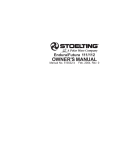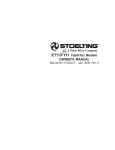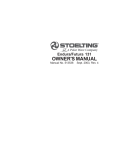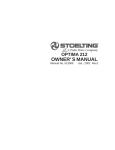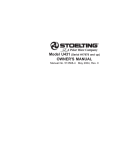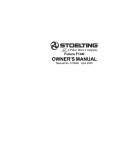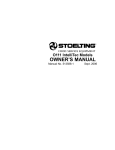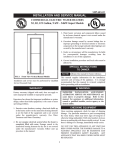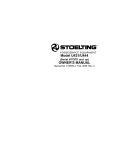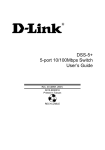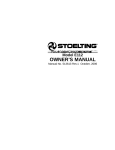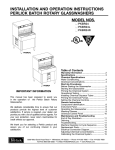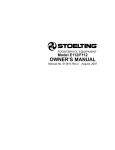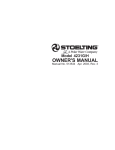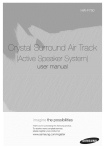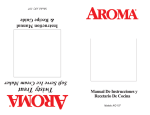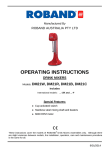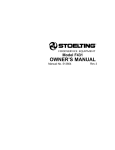Download Stoelting F131 User's Manual
Transcript
Futura F144 and F131 w/ Blender OWNER'S MANUAL Manual No. 513603-1 March 2005 Need Parts or Service? We stock the parts you need. Our Technicians are factory trained and are certified in the Stoelting Technicare program. CALL Distributor: _________________________ Phone No.: _________________________ (fill in or affix label) Model No.: _______________________ Serial No.: _______________________ Purchase Date: ____________________ Start-Up Date:____________________ Owner's Manual For Futura F144/SF144 Stoelting Counter Model Gravity Freezer Soft Serve/Shake This manual provides basic information about the freezer. Instructions and suggestions are given covering its operation and care. The illustrations and specifications are not binding in detail. We reserve the right to make changes to the freezer without notice, and without incurrring any obligation to modify or provide new parts for freezers built prior to date of change. DO NOT ATTEMPT to operate the freezer until instructions and safety precautions in this manual are read completely and are thoroughly understood. If problems develop or questions arise in connection with installation, operation, or servicing of the freezer, contact the company at the following location: STOELTING, LLC 502 Hwy. 67 Kiel, WI 53042 Ph: 920-894-2293 Fax: 920-894-7029 A Few Words About Safety Safety Information Read and understand the entire manual before operating or maintaining Stoelting equipment. This Owner's Manual provides the operator with information for the safe operation and maintenance of Stoelting equipment. As with any machine, there are hazards associated with their operation. For this reason safety is emphasized throughout the manual. To highlight specific safety information, the following safety definitions are provided to assist the reader. The purpose of safety symbols is to attract your attention to possible dangers. The safety symbols, and their explanations, deserve your careful attention and understanding. The safety warnings do not by themselves eliminate any danger. The instructions or warnings they give are not substitutes for proper accident prevention measures. Safety Alert Symbol: This symbol Indicates danger, warning or caution. Attention is required in order to avoid serious personal injury. The message that follows the symbol contains important information about safety. Signal Word: Signal words are distinctive words used throughout this manual that alert the reader to the existence and relative degree of a hazard. WARNING The signal word “WARNING” indicates a potentially hazardous situation, which, if not avoided, may result in death or serious injury and equipment/property damage. CAUTION If you need to replace a part, use genuine Stoelting parts with the correct part number or an equivalent part. We strongly recommend that you do not use replacement parts of inferior quality. The signal word “CAUTION” indicates a potentially hazardous situation, which, if not avoided, may result in minor or moderate injury and equipment/property damage. CAUTION The signal word “CAUTION” not preceded by the safety alert symbol indicates a potentially hazardous situation, which, if not avoided, may result in equipment/property damage. NOTICE The signal word “NOTICE” indicates information or procedures that relate directly or indirectly to the safety or personnel or equipment/property. TABLE OF CONTENTS SECTION 1 - SPECIFICATIONS .................................................................................. 1 1.1 Description ............................................................................................................ 1.2 Specifications ......................................................................................................... 1 2 SECTION 2 - INSTALLATION INSTRUCTIONS .......................................................... 2.1 Safety Precautions ................................................................................................. 2.2 Shipment and Transit ............................................................................................. 2.3 Freezer Installation ................................................................................................. 2.4 Floor Stand Installation ........................................................................................... 2.5 Installing Permanent Wiring .................................................................................... 3 3 4 4 5 5 SECTION 3 - INITIAL SET-UP AND OPERATION ....................................................... 7 3.1 Operator's Safety Precautions................................................................................ 7 3.2 Operating Controls and Indicators .......................................................................... 7 3.3 Sanitizing ............................................................................................................... 9 3.4 Freeze Down and Operation .................................................................................. 10 3.5 Mix Information ...................................................................................................... 11 3.6 Removing Mix from Freezer ................................................................................... 11 3.7 Cleaning the Freezer.............................................................................................. 12 3.8 Disassembly of Freezer Parts ............................................................................... 12 3.9 Cleaning the Freezer Parts .................................................................................... 14 3.10 Sanitize Freezer and Freezer Parts ....................................................................... 14 3.11 Assembly of Freezer.............................................................................................. 14 3.12 Routine Cleaning .................................................................................................... 16 3.13 Preventative Maintenance ...................................................................................... 16 3.14 Extended Storage .................................................................................................. 19 SECTION 4 - TROUBLESHOOTING ............................................................................ 21 4.1 Troubleshooting Chart ............................................................................................ 21 4.2 Error Code System ................................................................................................ 23 SECTION 5 - REPLACEMENT PARTS......................................................................... 25 5.1 How to Order Parts ............................................................................................... 25 WARRANTY .................................................................................................................. 27 LIST OF ILLUSTRATIONS Fig. Description Page 1 2 3 4 5 6 7 8 9 10 11 12 13 14 15 16 17 18 19 20 21 22 23 24 25 26 27 28 29 30 31 Model Endura/Futura 131G Freezer ................................................................... 1 Specifications .................................................................................................... 1 Warning Label Locations .................................................................................... 3 Space and Ventilation Requirements .................................................................. 4 Installing Tray and Insert ...................................................................................... 4 Power Cord ........................................................................................................ 4 Floor Stand ........................................................................................................ 5 Power Cord Connection ..................................................................................... 5 Controls ............................................................................................................. 7 Mix Inlet Regulator .............................................................................................. 9 Sanitizing Procedure .......................................................................................... 9 Clean Control ..................................................................................................... 9 Sanitizing Hopper ...............................................................................................10 Spigot Opened and Solution Draining .................................................................10 Sanitizing Agitator Shaft .....................................................................................10 Dispensing Product ............................................................................................11 Removing Mix Inlet Regulator .............................................................................11 Draining Mix .......................................................................................................12 Cleaning Agitator Shaft ......................................................................................12 Auger Flight Wear and Front Auger Support Wear .............................................13 Removing Front Door .........................................................................................13 Front Door Disassembly ....................................................................................13 Removing Agitator From Shaft ...........................................................................13 Removing Auger Support ...................................................................................13 Removing O-ring ................................................................................................14 Exploded View of Auger .....................................................................................15 Exploded View of Front Door .............................................................................15 Install Mix Inlet Regulators .................................................................................15 Condenser and Filter ..........................................................................................18 Cleaning Condenser ...........................................................................................18 Spigot, Front Door and Auger Assembly ............................................................26 SECTION 1 SPECIFICATIONS 1.1 DESCRIPTION The Stoelting Futura F144 and F131 w/ Blender countertop combination shake/softserve freezers are gravity fed. The freezers are equipped with fully automatic controls to provide uniform product. The freezer is designed to operate with almost any type of commercial soft serve and shake mixes available, including ice milk, ice cream, yogurt, and frozen dietary desserts. The F144 series freezers allow the operator to dispense outstanding soft serve from the left pigot, and thick creamy shakes from the right spigot, with the convenience and cost of one unit. The freezer is designed to be used with both barrels in operation. If you desire to use one barrel only, the freezer must be cleaned, sanitized and filled with fresh mix daily. The F131 freezer includes a blender for mixing fruit and berries into the dairy product for making smoothies. For more information call your authorized Stoelting Serviceperson. This manual is designed to assist qualified service personnel and operators in the installation, operation and maintenance of the Stoelting Model Futura 144 gravity freezer. Figure 1. Model Futura 144/F131 Freezer (F131 w/ blender shown mounted on the optional floor stand.) Figure 2. Specifications 1 1.2 SPECIFICATIONS MODEL FUTURA 144 COUNTERTOP COMBINATION SHAKE/SOFTSERVE GRAVITY FREEZER Dimensions: Freezer: 22" (56 cm) wide x 28" (72 cm) deep x 34.75" (88 cm) high Crated: 28" (71 cm) wide x 35 1/2" (89.4 cm) deep x 40.3" (102.4 cm) high Weight: Freezer: 385 lbs. (174.6 kg) Crated: 470 lbs. (213.2 kg) Electrical: Approximately 11 total running Amps, 20 Amp. maximum fuse or circuit breakers. NEMA 6-20P power cord provided. Automatic safeguard circuit built into electronic control - protects major freezer components under normal operating conditions. Refrigerant: R404a Compressor: 12,000 B.T.U.H./hr. Drive Motor: (2) 3/4 H.P. Cooling Air cooled requires minimum 3" air clearance on right and left hand side and rear. Minimum 10" top clearance Freezing Cylinder Volume Two cylinders, .85 gallon, 3.4 Quarts (3,22 liters) Hopper 2 each, 3 Gallons (11.35 liters) each refrigerated and insulated. 2 SECTION 2 INSTALLATION INSTRUCTIONS 2.1 SAFETY PRECAUTIONS Do not attempt to operate the freezer until the safety precautions and operating instructions in this manual are read completely and are thoroughly understood. Labels should be checked periodically to be sure they can be recognized as warning labels. If danger, warning or caution labels are needed, indicate the part number, type of label, location of label, and quantity required along with your address and mail to: Take notice of all warning labels on the freezer (Fig. 3). The labels have been put there to help maintain a safe working environment. The labels have been designed to withstand washing and cleaning. All labels must remain legible for the life of the freezer. STOELTING, INC. ATTENTION: Customer Service 502 HWY 67 Kiel, Wisconsin 53042-1600 Fig. 3. Warning Label Locations 3 2.2 SHIPMENT AND TRANSIT The freezer has been assembled, operated and inspected at the factory. Upon arrival at the final destination, the complete freezer must be checked for any damage which may have occurred during transit. CAUTION Failure to provide adequate ventalation will void Warranty. D. Place the OFF-ON switch in the OFF position. See Figure 8. With the method of packaging used, the freezer should arrive in excellent condition. THE CARRIER IS RESPONSIBLE FOR ALL DAMAGE IN TRANSIT, WHETHER VISIBLE OR CONCEALED. Do not pay the freight bill until the freezer has been checked for damage. Have the carrier note any visible damage on the freight bill. E. Install the drip trays, drain trays, covers and other miscellaneous parts on the freezer. (Fig. 5) If concealed damaged and/or shortage is found later, advise the carrier within 10 days and request inspection. The customer must place claim for damages and/or shortages in shipment with the carrier. Stoelting, Inc. cannot make any claims against the carrier. 2.3 FREEZER INSTALLATION Installation of the freezer involves moving the freezer close to its permanent location, removing all crating, setting in place, assembling parts, and cleaning. A. Uncrate the freezer. Figure 5. Installing Trays and Inserts (F131 w/ blender shown) B. Accurate leveling is necessary for correct drainage of freezer barrel and to insure correct overrun. Place a spirit level on top of the freezer at each corner to check for level condition. If adjustment is necessary, level the freezer by turning the bottom part of each leg in or out. Then separate freezer base gasket and install with the seam to the back and the flat to the bottom. F. Connect the power cord. The plug is designed for 208 or 230 volt/20 amp duty. Check the nameplate on your freezer for proper supply. The unit must be connected to a properly grounded receptacle. The electrical cord furnished as part of the freezer has a three prong grounding type plug (Fig. 6). The use of an extension cord is not recommended. If one must be used, use one with a wire size 12 gauge or heavier with a ground wire. Do not use an adaptor to get around grounding requirement. C. Air cooled freezers require correct ventilation. The right side of the freezer is the air intake and must have a 3" (7.5cm) clearance. Air discharges out of the left side of the unit and must have 3" (7.5cm) clearance. Do not obstruct the intake or discharge (Fig. 4). WARNING Do not alter or deform electrical plug in any way. Altering the plug to fit into an outlet of different configuration may cause fire, risk of electrical shock, product damage and will void the warranty. Fig. 4. Space and Ventilation Requirements Figure 6. Power Cord 4 2.4 FLOOR STAND INSTALLATION To install the F144 on the floor stand, follow the steps outlined below. 2.5 INSTALLING PERMANENT WIRING WARNING 1. Uncrate the floor stand and place in an upright posi tion. High voltage will shock, burn or cause death. Turn off and lock out main power disconnect before proceeding with installation. Do not operate machine with cabinet panels removed. NOTE Detailed instructions are included with each floor stand. 2. Place a spirit level across the top of the stand to check for level condition, side to side and front to back. If adjustment is necessary, level the stand by turning the bottom part of each caster in or out, then tighten the lock nut, and lock caster. Electrical materials, arrangement and grounding must conform with national and local electrical codes. If permanent wiring is required by local codes, the following procedure must be performed: A. Remove the back panel. 3. Remove the four legs from the freezer and replace with the four leg adapters provided. Adapters must be fully tightened to the freezer. B. Disconnect the wires from the terminal block. Disconnect the green ground wire from the grounding stud. 4. Place the F144 freezer on the floor stand with the front of the freezer to the door end of the stand. Secure the freezer to the stand with the nuts and lock washers provided. Then separate freezer base gasket and install the seam to the back and the flat to the bottom (Fig. 7). Figure 8. Power Cord Connection C. Remove the power cord. D. Install permanent wiring according to local code. E. Replace the back panel. Fig. 7. Floor Stand 5 6 SECTION 3 INITIAL SET-UP AND OPERATION 3.1 OPERATOR'S SAFETY PRECAUTIONS SAFE OPERATION IS NOT AN ACCIDENT; Observe these rules: G. Do not operate under unsafe operating condi tions. Never operate the freezer if unusual or exces sive noise or vibration occurs. A. Know the freezer. Read and understand the Operating Instructions. 3.2 OPERATION CONTROLS AND INDICATORS Before operating the freezer, it is required that the operator know the function of each operating control. Refer to Figure 9 for the location of the operating controls on the freezer. B. Notice all warning labels on the freezer. C. Wear proper clothing. Avoid loose fitting garments, and remove watches, rings or jewelry which could cause a serious accident. D. Maintain a clean work area. Avoid accidents by cleaning up the area and keeping it clean. A. SPIGOT SWITCH The SPIGOT switch will automatically actuate the auger drive and refrigeration systems when the spigot is opened to dispense product. When the spigot is closed, the drive motor and compressor will remain "on" until the product in the barrel reaches the proper consistency. E. Stay alert at all times. Know which switch, push button or control you are about to use and what effect it is going to have. F. Disconnect electrical cord for maintenance. Never attempt to repair or perform maintenance on the freezer until the main electrical power has been disconnected. Dispense Rate Adjuster Off-On Switch Hold Ready Switch Push To Freeze Switch Off-On Switch Green Light Clean Switch Mix Low Light Figure 9. Controls 7 WARNING E. CLEAN SWITCH The CLEAN switch is a "snap" switch. When the switch is pushed the refrigeration system will be OFF and the auger will rotate for cleaning. When the switch is pushed again, the auger will stop and the CLEAN light will flash indicating the freezer is in the CLEAN mode. To exit the CLEAN mode turn the OFF-ON switch to the OFF position. If the freezer is left in CLEAN for more than 30 minutes or is pushed three times in ten seconds, it will go in error. High voltage will shock, burn or cause death. The OFF-ON switch must be placed in the OFF position prior to disassembling for cleaning or servicing. Do not operate machine with cabinet panels removed. B. OFF-ON SWITCH The OFF-ON switch is a two position toggle switch used to supply power to the control circuit. When the switch is in the OFF position, nothing will turn. When the switch is in the ON position, the freezer can be run in the freezing mode or cleaning mode. The freezer will be in the idle mode until a switch is activated. F. DRIVE MOTOR OVERLOAD The internal drive motor overload will trip if the drive motor is overloaded. It will reset after approximately 10-12 minutes. If the drive motor continues to trip, refer to Section 4-Troubleshooting. C. PUSH TO FREEZE SWITCH The PUSH TO FREEZE switch is a "snap" switch used to start the freezing cycle. During initial freeze down, the OFF-ON switch is placed in the ON position. Then the PUSH TO FREEZE switch is pressed until the drive motor and compressor come "ON". G. RED MIX LOW LENS The red MIX LOW light is designed to alert the operator to a low mix condition. The lens will illuminate with approximately one gallon of mix in the hopper. When the MIX LOW lens is lit, refill hopper immediately. NOTE Failure to immediately refill hopper may result in operational problems. NOTE After the auger drive motor starts, there is a 3 second delay before the compressor starts. H. HOLD READY SWITCH The HOLD READY switch is a push button switch. When pushed in and held for 5 seconds, the hold ready mode will be activated. The product will remain ready to serve and the freezer will not go to idle. To return to normal operation push and hold for 5 seconds. During the normal operation, the red PUSH TO FREEZE switch light will illuminate after the freezer has been idle for the preset cycles. Before drawing product, press the red PUSH TO FREEZE switch if it is illuminated. Wait until the green light is illuminated before dispensing. I. HIGH PRESSURE CUTOUT The HIGH PRESSURE CUTOUT switch is a safety switch designed to protect the compressor from damage due to excessive head pressure. When tripped, the lever will be out, push in to reset. NOTE If the freezer shuts off and the PUSH TO FREEZE light flashes, you have an error condition. Turn the OFF-ON switch to the OFF position, correct the problem and turn the freezer back on. (See Troubleshooting.) J. DISPENSE RATE ADJUSTER The DISPENSE RATE ADJUSTER limits the opening of the spigot. D. GREEN LIGHT The green light is used to indicate that the product has reached the proper consistency and is ready to be dispensed. The light begins to flash at 98% of consistency. To adjust product dispense rate, turn the adjusting knob clockwise for slower flow and counterclockwise for faster flow. K. DOOR INTERLOCK SWITCH When the door is securely fastened, the freezer will operate normally. When the door is removed, the drive and compressor will not run. NOTE If the PUSH TO FREEZE red light is illuminated, push the PUSH TO FREEZE switch and wait until the green light illuminates before dispensing. 8 L. BLENDER POWER SWITCH (F131 Models Only) The blender power switch is a two position toggle switch used to supply power to the blender. When the switch is in the OFF position, the agitator will not turn. When the switch is in the ON position, the agitator will be activated every time the blender activation switch is pressed. M. BLENDER ACTIVATION SWITCH (F131 Models Only) The blender activation switch is a two speed, momen tary contact switch that will actuate the agitator to blend product when pressed in and held in either the HIGH or LOW speed position. The HIGH speed position is used to blend fruit into dairy mix when making smoothies. The LOW speed position is used during cleaning procedures. Figure 10. Mix Inlet Regulator B. Prepare 2 gallons (7.5 liters) of sanitizing solution following manufacturer’s instructions. Pour into hopper with mix inlet regulator in place (Fig. 11). 3.3 SANITIZING Sanitizing must be done after the freezer is clean and just before the hopper is filled with mix. Sanitizing the night before is not effective. However, you should always clean the freezer and parts after using it. THE UNITED STATES DEPARTMENT OF AGRICULTURE AND THE FOOD AND DRUG ADMINISTRATION REQUIRE THAT ALL CLEANING AND SANITIZING SOLUTIONS USED WITH FOOD PROCESSING EQUIPMENT BE CERTIFIED FOR THIS USE. When sanitizing the freezer, refer to local sanitary regulations for applicable codes and recommended sanitizing products and procedures. The frequency of sanitizing must comply with local health regulations. Mix sanitizer according to manufacturer’s instructions to provide a 100 parts per million strength solution. Mix sanitizer in quantities of no less than 2 gallons (7.5 liters) of 120°F of water. Allow sanitizer to contact the surfaces to be sanitized for 5 minutes. Any sanitizer must be used only in accordance with the manufacturer’s instructions. Figure 11. Sanitizing Procedure C. Place the OFF-ON toggle switch in the ON position while pressing the CLEAN switch. Check for leaks. (Fig. 12) CAUTION Do not allow sanitizer to remain in contact with stainless steel freezer parts for prolonged periods. Prolonged contact of sanitizer with freezer may cause corrosion of stainless steel parts. In general, sanitizing may be conducted as follows: A. Push the mix inlet regulator into hopper with air inlet (long) tube toward the front of the freezer. (Fig. 10). Figure 12. Clean Control 9 D. Clean sides of hopper, mix inlet regulator and underside of hopper cover using a sanitized soft bristle brush dipped in the sanitizing solution (Fig. 13). Figure 15. Sanitizing Agitator Shaft Figure 13. Sanitizing Hopper E. After five minutes, place a bucket under the spigot and open spigot to drain sanitizing solution. When solution has drained, press the CLEAN snap switch to stop the auger. Allow the freezer barrel to drain completely (Fig. 14). 3.4 FREEZE DOWN AND OPERATION This section covers the recommended operating procedures to be followed for the safe operation of the freezer. A. Sanitize just prior to use. B. Place the OFF-ON switch in the OFF position. C. With spigots open, pour approximately 1 gallon (3.8 liters) of mix into the hopper. Allow the mix to flush out about 8 ounces (0.23 liters) of sanitizing solution and liquid mix. Close the spigot. D. Fill hopper with approximately 3 gallons (11.4 liters) of prechilled (40°F or 4°C) mix. NOTE Do not overfill the hopper. Mix level must not be higher than 2 inches (5 cm) from the top of the air inlet tube on the mix inlet regulator. Figure 14. Spigot Opened and Solution Draining F. Fill a tall cup with sanitizing solution. Completely immerse the blender's agitator shaft in the sanitizer solution. Do not wipe dry (Fig. 15). E. The freezer barrel will automatically fill until it is about 1/2 full. If freezer barrel does not fill, check for obstruction in the mix inlet regulator. If freezer barrel fills over 1/2 full, indicated by low overrun, check for leaks at the mix inlet regulator O-ring or check if the mix inlet regulator was installed correctly or that the freezer is level. F. Place the OFF-ON switch in the ON position, then press the PUSH TO FREEZE swtich until the freezer starts. NOTE After the auger drive motor starts, there is a 3 second delay before the compressor starts. 10 G. After about 6 to 10 minutes the freezer will shut off and the green lens will illuminate. The product will be ready to serve. Freeze down time may be longer for some frozen diet dessert mixes. High ambient temperatures may extend freeze down time. H. For normal dispensing, move the spigot handle fully open (Fig. 16). 3.5 MIX INFORMATION Mix can vary considerably from one manufacturer to another. Differences in the amount of butterfat content and quantity and quality of other ingredients have a direct bearing on the finished frozen product. A change in freezer performance that cannot be explained by a technical problem may be related to the mix. When changing from one type of mix to another such as yogurt to Vitari, you may have to change the mix inlet regulator and/or control settings. Please call your distributor for further information. Proper product serving temperature varies from one manufacturer’s mix to another. Mixes should provide a satisfactory product in the 18° to 20°F (-7° to -6°C) range. When checking the temperature, stir the thermometer in the frozen product to read the true temperature. Figure 16. Dispensing Product I. The freezer is designed to dispense the product at a reasonable draw rate. If the freezer is overdrawn, the result is a soft product or a product that will not dispense at all. If this should occur, allow the freezer to run for approximately 30 seconds before dispensing additional product. After a while the operator will sense or feel when the freezer is beginning to fall behind, and will slow down on the rate of draw so as not to exceed the capacity. J. Do not operate the freezer when the MIX LOW light is on or with less than 1-3/4" (4.4 cm) of mix in the hopper. Refill the hopper immediately. Mix does not improve with age. Old mix, or mix that has been stored at too high a temperature, can result in a finished product that is less than satisfactory in taste and appearance. To retard bacteria growth in dairy based mixes, the best storage temperature range is between 36° to 40°F (2.2° to 4.4°C). Some products tend to foam more than others. If excess foam should occur, skim the foam off with a sanitized utensil and discard. Periodically, stir the mix in the hopper with a sanitized utensil. 3.6 REMOVING MIX FROM THE FREEZER To remove the mix from the freezer, refer to the following steps: A. Remove the mix inlet regulator from the hopper by pulling straight up (Fig.17). NOTE The freezer has a standby mode sometimes referred to as a sleep or energy conservation mode. When the freezer is not used, after a preset time, it will enter the standby mode and remain there until someone draws a product or pushes the push-to-freeze switch. In the standby mode, the freezer will keep the product below 45°F. Standby modes are not to be used in place of cleaning and sanitizing. Frequency of cleaning and sanitizing is determined by Federal, State, and local regulatory agencies. Figure 17. Removing Mix Inlet Regulator 11 B. Place the OFF-ON rocker switch in the ON position and push the CLEAN switch to rotate the auger. Allow the mix to agitate in the freezer barrel until the mix has become a liquid, about 5 minutes. CAUTION Hazardous Moving Parts Revolving blender agitator shaft can grab and cause injury. Remove watches and jewelry prior to operating blender. Keep hands and clothing away from revolving agitator. The Power switch must be placed in the OFF position for cleaning and when not in use. C. Drain the liquid mix by opening the spigot. A bucket or container should be placed under the spigot to catch the liquid mix (Fig. 18). E. Fill a tall cup with clean 110°F (43°C) water. Press the low speed on the blender activation switch and allow agitator to run for 10 to 15 seconds (See Figure 19). Figure 18. Draining Mix 3.7 CLEANING THE FREEZER NOTE The frequency of cleaning the freezer and freezer parts must comply with state and local health regulations. After the mix has been removed from the freezer, the freezer must be cleaned. To clean the freezer, refer to the following steps: Figure 19. Cleaning Agitator Shaft F. Repeat steps A through E using a mild detergent solution. 3.8 DISASSEMBLY OF FREEZER PARTS A. Close the spigot and fill the hopper with 2 gallons (7.5 liters) of cold tap water. CAUTION Hazardous Moving Parts Revolving auger shaft can grab and cause injury. Place the POWER OFF-ON switch in the OFF position before disassembling for cleaning or servicing. B. Place the OFF-ON switch in the ON position while pushing the CLEAN switch to rotate the auger. C. Allow the water to agitate for approximately five minutes. NOTE If freezer is left in CLEAN for more than 30 minutes, it will go to error. Refer to Section 4 for instructions on clearing the error. D. Open the spigot to drain the water. Remember to place a bucket or container under the spigot to catch the water. When the water has drained, turn the OFF-ON switch to the OFF position. Allow the freezer barrel to drain completely. Inspection for worn or broken parts should be made at every disassembly of the freezer for cleaning or other purposes. All worn or broken parts should be replaced to ensure safety to both the operator and the customer and to maintain good freezer performance and a quality product. Two normal wear areas are the auger flights and front auger support bushing (Fig. 20). Frequency of cleaning must comply with the state and local health regulations. 12 Figure 20. Auger Flight Wear and Front Auger Support Bushing Wear D. Place the OFF-ON switch in the OFF position. To disassemble the freezer, refer to the following steps: A. Remove the mix inlet regulator from the hopper by pulling straight up. B. Remove the front door by turning off the circular knobs and then pulling the front door off the studs (Fig. 21). Figure 22. Front Door Disassembly D. Remove the clear acrylic splash gaurd from the blender. E. Remove the blender's agitator from the agitator shaft. Grasp the agitator shaft in one hand, and turn the agitator in a clockwise direction with the other hand (Fig. 23). Figure 23. Removing Agitator From Shaft Figure 21. Removing Front Door D. Remove the front auger supports and bushings (Fig. 24). C. Remove the rosette caps from the front door. Push the spigot body through the bottom of the front door and remove. (Fig. 22). Figure 24. Removing Auger Supports 13 NOTE Clean the auger drive socket located inside the barrel at the rear seal area. Use clean cloth or paper towel for this purpose. G. Remove the auger assemblies from the freezer. Pull the augers out of the freezer barrel slowly. As the augers are being pulled out, carefully remove each of the plastic flights with springs. H. Keep the rear of the auger shafts tipped up once they D. Clean the drip trays and insert with a soap solution. Rinse with clean hot water. are clear of the freezer barrels to avoid dropping rear seals. 3.10 SANITIZE FREEZER AND FREEZER PARTS I. Wipe socket lubricant from the drive end (rear) of the A. Use a sanitizer mixed according to manufacturer’s auger with a cloth or paper towel. instructions to provide a 100 parts per million strength solution. Mix sanitizer in quantities of no J. Remove the rear seals. less than 2 gallons (7.5 liters) of 120°F water. Allow the sanitizer to contact the surfaces to be sanitized K. Remove all O-rings from parts by first wiping off the for 5 minutes. Any sanitizer must be used only in lubricant using a clean paper towel. Then squeeze the accordance with the manufacturer’s instructions. O-ring upward with a dry cloth (Fig. 25). When a loop is formed, roll out of the O-ring groove. B. Place all parts in the sanitizing solution, then remove and let air dry. C. Using this sanitizing solution and the large barrel brush provided, sanitize the rear of the barrel and drive area by dipping the brush in the sanitizing solution and brushing the rear of the barrel. 3.11 ASSEMBLY OF FREEZER To assemble the freezer parts, refer to the following steps: NOTE Petrol-Gel sanitary lubricant or equivalent must be used when lubrication of parts is specified. NOTE The United States Department of Agriculture and Food and Drug Administration require that lubricants used on food processing equipment be certified for this use. Use lubricants only in accordance with the manufacturer’s instructions. Figure 25. Removing O-ring CAUTION Do not use any type of sharp object to remove Orings. Using tools to remove O-rings may damage spigot and O-rings. 3.9 CLEANING THE FREEZER PARTS Place all loose parts in a pan or container and take to the wash sink for cleaning. To clean freezer parts refer to the following steps: A. Place all parts in warm mild detergent water and clean with brushes provided. Rinse all parts with clean hot water. B. Wash the hopper and freezer barrel with warm detergent water and brushes provided. A. Assemble all o-rings onto parts dry, without lubrication. Then apply a thin film of sanitary lubrication to exposed surfaces of the O-rings. Apply a thin film of sanitary lubricant to metal part of rear seal. Also apply a thin film of sanitary lubricant inside the hole of the front of the auger. B. Assemble the rear seals onto the augers with the large end to the rear. Be sure the O-ring is in place before installing the rear seal. C. Lubricate the inside of the auger drive sockets (rear) with a small amount of white socket lubricant. A small container of socket lubricant is shipped with the freezer. C. Clean the rear seal surfaces from the inside of the freezer barrel with warm detergent water. 14 D. Screw the springs onto the studs in plastic flights. Springs must be screwed into the flights com pletely to provide compression (Fig. 26). Figure 27. Exploded View of Front Door Figure 26. Exploded View of Auger I. Install the front door on the freezer. J. Install the circular knobs on the freezer studs. CAUTION CAUTION Do not place the mix inlet regulator into the hopper before installing the auger. Attempting to install the auger with mix inlet regulator in place will damage the mix inlet regulator. E. Install the two plastic flights onto rear of the auger and insert part way into freezer barrel. Overtightening or uneven tensioning of circular knobs may cause damage to front door and cause leaking. Hand tighten circular knobs evenly. Look for the proper seal between the freezer barrel, Oring, and front door. K. Install the mix air regulator into the freezer with the air tube to the front of the freezer. (Fig. 28). F. Install the third plastic flight, push the auger into the freezer barrel and rotate slowly until the auger engages the drive socket. G. Install the auger support and bearing into the front of the augers with one leg of the support at 9 o’clock. NOTE Apply a small amount of Petro-Gel to the surface of the cam on the spigot handle prior to assembly of handle to the spigot body. H. Install the spigot bodies with O-rings into the front door from the bottom (Fig.27). Push straight up until the spigots are in place. Install rosette caps. Figure 28. Install Mix Inlet Regulators L. Thread agitator onto blender agitator shaft. (Fig. 23). NOTE Refer to page 3-2, section 3.3, for sanitizing the assembled freezer before filling with mix. 15 Important Differences Between Cleaning and Sanitizing 3.12 ROUTINE CLEANING To remove spilled or dried mix from the freezer exterior, simply wash in the direction of the finish with warm soapy water and wipe dry. Do not use highly abrasive materials as they will mar the finish. CLEANING vs. SANITIZING It is important to distinguish between cleaning and sanitizing. Although these terms may sound synonymous, they are not. BOTH are required for adequate food safety and proper machine maintenance. 3.13 PREVENTIVE MAINTENANCE It is recommended that a maintenance schedule be followed to keep the freezer clean and operating properly. CLEANING · Is the removal of soil materials from a surface. · Is a prerequisite for effective sanitizing. A. Cleaning and Sanitizing Information Soft serve freezers require special consideration when it comes to food safety and proper cleaning and sanitizing. The following information has been compiled by Purdy Products Company, makers of Stera-Sheen Green Label Cleaner/Sanitizer and specifically covers issues for cleaning and sanitizing frozen dessert machines. This information is meant to supplement a comprehensive food safety program. NOTE An UNCLEAN surface will harbor bacteria that can defy sanitizing efforts. Bacteria can develop and resist sanitizing efforts within a layer of soil material (milkstone). Thorough cleaning procedures that involve milkstone removal are critical for operators of frozen dessert machines. SANITIZING · Kills bacteria. · Can be effective on clean surfaces only. · DOES NOT clean or remove milkstone. Soil Materials Associated with Frozen Dessert Machines MILKFAT/BUTTERFAT – As components of icecream/frozen custard mix, these soils will accumulate on the interior surfaces of the machine and its parts. Fats are difficult to remove and help attribute to milkstone build-up. NOTE Using a SANTITIZER on an unclean surface will not guarantee a clean and safe frozen dessert machine. MILKSTONE – Is a white/gray film that forms on equipment and utensils that come in contact with dairy products. These films will accumulate slowly on surfaces because of ineffective cleaning, use of hard water, or both. Milkstone is usually a porous deposit, which will harbor microbial contaminants and eventually defy sanitizing efforts. Proper Daily Maintenance: The Only Way to Assure Food Safety and Product Quality Proper daily maintenance can involve a wide variety of products and procedures. Overall, the products and procedures fall into three separate categories. (Please note that this is a brief overview intended for informational purposes only.) 1. CLEANING – This involves draining mix from the freezer barrel and rinsing the machine with water. Next, a cleaner is run through the machine. Then, the machine is disassembled and removable parts are taken to the sink for cleaning. Once milkstone has formed, it is very difficult to remove. Without using the correct product and procedure, it is nearly impossible to remove a thick layer of milkstone. (NOTE: general-purpose cleaners DO NOT remove milkstone.) This can lead to high bacteria counts and a food safety dilemma. 2. IT IS BEST TO CONTROL MILKSTONE ON A DAILY BASIS BEFORE IT CAN BECOME A SIGNIFICANT FOOD SAFETY PROBLEM. In addition to food safety, milkstone can cause premature wear to machine parts which can add to costs for replacement parts or possibly more expensive repairs if worn machine parts are not replaced once they have become excessively worn. 16 MILKSTONE REMOVAL – Since almost all cleaners do not have the ability to remove milkstone, the use of a delimer becomes necessary. Although this procedure may not be needed on a daily basis, it will usually follow the cleaning procedure. It requires letting a delimer solution soak in the machine for an extended period of time. Individual parts are also soaked in a deliming solution for an extended period of time (more about delimers in Additional Information). 3. THE USE OF CHLORINE TEST STRIPS SANITIZING – After the machine has been cleaned and contains no milkstone, the machine is reassembled. Then a FDA approved sanitizing solution is run through the machine to kill bacteria. The machine is then ready for food preparation. “Test strips” are used to determine concentrations of active chlorine in sanitizing solutions. To use the strips, tear off a small portion and submerge it into the sanitizing solution. Then, compare the color change to the color key on the side of the test strip dispenser to determine the approximate chlorine concentration. As a recommended cleaner and sanitizer for your frozen dessert machine, STERA-SHEEN has proven to be one of the best daily maintenance products for: · The ideal concentration of chlorine needs to be 100 ppm (as stated by the FDA). CLEANING – Thorough removal of all solids including butterfat and milk fat. · MILKSTONE REMOVAL – Complete removal of milkstone. · SANITIZING – FDA-approved no rinse sanitizer for food contact surfaces. NOTE Follow the directions on the container for proper concentration. There are two main factors that contribute to falling chlorine concentrations in a sanitizing solution. 1. Additional Information THE USE OF DELIMERS A delimer is a strong acid that has the ability to dissolve milkstone. This type of chemical may become necessary once high levels of milkstone have developed. While these products are very effective for removing HIGH levels of milkstone, they are not ideal for two reasons: 1. 2. PRODUCT SAFETY – Strong acids are dangerous chemicals and handling them requires safety 2. TIME – As time passes, small amounts of chlorine “evaporate” from the solution. (That is why you can smell it.) Sanitizing solutions should not be allowed to fall below 100 ppm chlorine. New solutions should be mixed once old solutions become ineffective B. DAILY 1. MACHINE DAMAGE – Strong acids will attack metal and rubber causing premature wear of parts. The use of a delimer needs to be closely monitored to avoid damage to machine surfaces and parts. The exterior should be kept clean at all times to preserve the lustre of the stainless steel. A mild alkaline cleaner is recommended. Use a soft cloth or sponge to apply the cleaner. CAUTION With proper daily use of STERA-SHEEN or it’s equivalent, there is no need for the use of a DELIMER. DO NOT USE BLEACH · BLEACH HAS ABSOLUTELY NO CLEANING PROPERTIES. · BLEACH IS CORROSIVE. It can and will damage components of the machine causing premature wear and metal corrosion. PRODUCT USE – As the chlorine in the solution is being used, chlorine concentrations fall. Do not use acidic cleansers, stron caustic compounds or abrasive materials to clean any part of the freezer exterior or plastic parts. Use of these types of cleaners will cause equipment damage. C. WEEKLY 1. Check O-rings and rear seal for excessive wear and replace if necessary. 2. Remove the drip tray by gently lifting up to disengage from the support and pulling out. Clean behind the drip tray and front of the freezer with a soap solution. GENERAL PURPOSE CLEANERS General purpose cleaners do not have the ability to remove milkstone. Milkstone will become a problem if not remedied with additional products and procedures. 17 D. QUARTERLY WARNING High voltage will shock, burn or cause death. Turn off and lock out main power disconnect before servicing. Do not operate machine with cabinet panels removed. The air-cooled condenser is a copper tube and aluminum fin type. Condensing is totally dependent upon airflow. A plugged condenser filter, condenser, or restrictions in the louvered panel will restrict airflow. This will lower the capacity of the system and damage the compressor. The condenser must be kept clean of dirt and grease. The freezer must have a minimum of 3” (7.5 cm) of ventilation on the right and left sides of the unit for free flow of air (Figure 29). Make sure the freezer is not pulling over 100° F (37° C) air from other equipment in the area. The water-cooled condenser is a tube and shell type. The condenser needs a cool, clean supply of water to properly cool the freezer, inlet and discharge lines must be 3/8” I.D. minimum. Figure 29. Condenser and Filter 5. Using a vacuum, carefully clean the condenser coil from the inside and outside of the freezer. A stiff bristled brush may help in releasing debris from between the condenser coils. The condenser and condenser filter require periodic cleaning. To clean, refer to the following procedures. 1. Remove the Phillips head screw from the bottom of the right side panel, and then slide the panels down and out. 2. To remove the condenser filter, grasp the top and pull off. Visually inspect for dirt. If the filter is dirty, shake or brush excess dirt off the filter and wash in warm, soapy water. Once the filter is clean rinse thoroughly in warm, clear water and shake dry, taking care not to damage the filter in any way Figure 29). Figure 30. Cleaning Condenser NOTE If the condenser is not kept clean, loss of refrigeration efficiency will result; causing extended run time or soft product consistency. 3. Visually inspect the condenser for dirt by shining a light through the coil from the back (inside) of the condenser. 4. If the condenser is dirty, place a wet towel over the front (outside) of the condenser. Water-cooled condensers need an unrestricted supply of cold, clean water. 18 20 SECTION 4 TROUBLESHOOTING CHARTS PROBLEM Freez er does not run. POSSIBLE CAUSE REMEDY 1. Power to freezer is off. 2. Fuse or circuit if blown or tripped. 3. Freeze-up (auger will not turn). 4. High pressure cut-out tripped. 5. Front door not in place. Freez er does not run, PUSH TO FREEZE light flashes. 1. Freezer has been left in the CLEAN mode for more than 30 minutes. 2. CLEAN switch has been activated 3 times within 10 seconds. 3. Low torque error. Freez er w ill not shut off. Product is too soft. 1. Let light flash for 10 minutes, then place the OFF-ON switch to the OFF position to reset. 2. Leave OFF-ON switch in the ON position for 10 minutes, then place the OFF-ON switch to the OFF position to reset. 3. Place the OFF-ON switch to the OFF position to reset. 1. Not enough mix in hopper. 2. Drive belt failure. 3. Consistency temperature setting is too firm. 4. Consistency temperature control failure. 5. Refrigeration problem. 1. Fill hopper with mix. 2. Replace drive belt. 3. Readjust. (Call distributor for service.) 1. Product is being dispensed when the PUSH TO FREEZE light is illuminated red. 2. No vent space for free flow of cooling air. 3. Air temperature entering condenser is above 100°F. 4. Condenser is dirty. 5. Consistency setting too soft. 6. Stabilizers in mix are broken down. 7. Auger is assembled wrong. 1. Press the PUSH TO FREEZE push button. Wait until the green light illuminates before dispensing. 2. A minimum of 3 inches of vent space required. 3. Change location or direct hot air away from freezer. 4. Clean. 5. Readjust. (Call distributor for service.) 6. Remove mix, clean, sanitize and freeze down with fresh mix. 7. Remove mix, clean, reassemble, sanitize and freeze down. 8. Check system. (Call distributor for service.) 8. Refrigeration problem. Product is too firm. 1. Supply power to freezer. 2. Replace or reset. (If condition continues, see notes 1 or 2). 3. Turn OFF-ON switch to OFF for 15 minutes, then restart. 4. Reset high pressure cut-out. 5. Assemble front door in place. 1. No mix in hopper. 2. Small portions are being dispensed in a short time. 3. Consistency temperature setting is too firm. 4. Consistency temperature control failure. 5. Line voltage fluctuating. 21 4. Replace. (Call distributor for service.) 5. Check system. (Call distributor for service.) 1. Fill hopper with mix. 2. Allow freezer to sit idle for 5 minutes before dispensing. 3. Readjust. (Call distributor for service.) 4. Replace. (Call distributor for service.) 5. Check. (Call distributor for service.) PROBLEM Product does not dispense. POSSIBLE CAUSE REMEDY 1. No mix in hopper. 2. Mix inlet regulator tube is plugged. 3. Special mix inlet regulator needed for mix being used. 4. Capacity of freezer is being exceeded. 5. Drive motor overload tripped. 6. Drive belt failure. 7. Freeze-up. (Auger will not turn.) 1. Fill hopper with mix. 2. Unplug, using small sanitized brush. 3. Order special mix inlet regulator. 4. Slow up on the draw rate. 5. Wait 30 minutes for drive motor overload to reset. (If condition continues, call distributor for service.) 6. Replace drive belt. 7. Turn OFF-ON switch to OFF for 15 min., then restart. Drive belt slipping or squealing. 1. Worn drive belt. 2. Freeze-up (Auger will not turn). 1. Replace drive belt. 2. Turn OFF-ON switch to OFF for 15 min., then restart. Low overrun. 1. Auger is assembled wrong. 1. Remove mix, clean, sanitize, and freeze down with fresh mix. 2. Replace mix inlet regulator. 3. Replace mix inlet regulator O-ring. 2. Mix inlet regulator missing. 3. Mix inlet regulator O-ring missing. 4. Mix inlet regulator air tube blocked. 5. Product breakdown. Front door leaks Hopper w ill not maintain mix temperature below 45°F (7°C) 4. Clean with sanitized brush. 5. Fill freezer with fresh product. 1. Front door knobs are loose. 2. Spigot parts are not lubricated. 3. Chipped or worn spigot O-rings. 4. O-rings or spigot installed wrong. 5. Inner spigot hole in front door nicked or scratched. 1. Tighten knobs. 2. See paragraph 3.11 3. Replace O-rings. 4. Remove spigot and check O-ring. 1. Consistency control on board needs to be adjusted. 2. Consistency control failure. 3. EPR valve needs adjustment. 4. Refrigeration problem. 1. (Call distributor for service.) 5. Replace front door. 2. Replace. (Call distributor for service.) 3. Adjust EPR valve. (Call distributor for service.) 4. Check system. (Call distributor for service.) 22 ERROR CODE SYSTEM CODE P.T.F. LIGHT FLASHES MEANING 01 Sequence of one * Program board 02 Sequence of two * Power board 03 Sequence of three * Low torque error 04 Sequence of four ** Clean error 05 Sequence of five * Barrel sensor 06 Sequence of six * Hopper sensor 07 Sequence of seven * Drive motor *Refer to Page 19 for Troubleshooting. **If the Clean switch is operated three times within 10 seconds, this will cause the Push-To-Freeze light to flash and the clean function will be disabled for 10 minutes. The power switch must remain on or the 10 minute timer will not time out. A flashing clean light is not an error. NOTE Flashing CLEAN light is not an error. It indicates the freezer is in the CLEAN mode. To exit, turn the OFF-ON switch to the OFF position. 23 24 SECTION 5 REPLACEMENT PARTS 5.1 HOW TO ORDER PARTS To assure receipt of the proper replacement parts, supply your dealer or distributor with the following information: B. Serial number of model, stamped on nameplate. C. Part number, part name and quantity needed. Common part names and numbers are listed in this manual. A. Model number of equipment. O-RING IDENTIFICATION SHEET MODEL FUTURA 144 Spigot (4) 624598-5 5/8" ID x 1/8" CS Front Door (1) 625133 4" ID x 3/16" CS Mix Inlet Regulator (1) 624677-5 1-1/8" ID x 1/8" CS O-rings are drawn to Approximate Size 25 16 2 2 1 3 4 17 3 18 6 7 5 19 8 10 11 12 9 13 9 7 Figure 31. Spigot, Front Door and Auger Assembly Item No. Part No. Description Qty. 1 11 12 13 14 15 16 17 18 19 20 21 3170644 149003 4157968 624678 666786 522839 274031 674147 521026 744299 681514 Front Door Only 1.5" Spigot Extension 2.5" Spigot Extension 3" Spigot Extension Circular Door Knob O-ring Front Door Spigot O-ring Spigot (5 Pack) Rosette Cap Auger Flight Mix Inlet Regulator Auger Spring O-ring Mix Inlet Regulator and Spigot Extension (5 Pack) Front Auger Support Auger Bushing Auger Shaft O-ring Auger Shaft Seal (5 Pack) Auger Shaft Seal Blender Motor Blender Agitator Collar Blender Agitator Shaft Blender Agitator Blender Drip Tray (Not Shown) Clear Swing Splash Shield (Not Shown) 1 2 3 4 5 6 7 8 9 10 2183047 2177072 2177073 2177074 482019 625133 3159696 624598-5 232734 381804 2149243-01 694255 624677-5 26 4 2 2 4 2 8 2 8 6 2 2 2 2 2 1 1 1 1 1 1 14 15 WARRANTY SOFT SERVE / SHAKE FREEZERS 1. Scope: Stoelting, LLC warrants to the first user (the “Buyer”) that the freezer cylinders, hoppers, compressors, drive motors, speed reducers, auger and auger flights of Stoelting soft serve / shake freezers will be free from defects in materials and workmanship under normal use and proper maintenance appearing within five (5) years, and that all other components of such equipment manufactured by Stoelting will be free from defects in material and workmanship under normal use and proper maintenance appearing within twelve (12) months after the date that such equipment is originally installed. 2. Disclaimer of Other Warranties: THIS WARRANTY IS EXCLUSIVE; AND STOELTING HEREBY DISCLAIMS ANY IMPLIED WARRANTY OF MERCHANTABILITY OR FITNESS FOR PARTICULAR PURPOSE. 3. Remedies: Stoelting’s sole obligations, and Buyer’s sole remedies, for any breach of this warranty shall be the repair or (at Stoelting’s option) replacement of the affected component at Stoelting’s plant in Kiel, Wisconsin, or (again, at Stoelting’s option) refund of the purchase price of the affected equipment, and, during the first twelve (12) months of the warranty period, deinstallation/reinstallation of the affected component from/into the equipment. Those obligations/remedies are subject to the conditions that Buyer (a) signs and returns to Stoelting, upon installation, the Checklist/Warranty Registration Card for the affected equipment, (b) gives Stoelting prompt written notice of any claimed breach of warranty within the applicable warranty period, and (c) delivers the affected equipment to Stoelting or its designated service location, in its original packaging/crating, also within that period. Buyer shall bear the cost and risk of shipping to and from Stoelting’s plant or designated service location. 4. Exclusions and Limitations: This warranty does not extend to parts, sometimes called “wear parts”, which are generally expected to deteriorate and to require replacement as equipment is used, including as examples but not intended to be limited to o-rings, auger seals, auger support bushings and drive belts. All such parts are sold AS IS. Further, Stoelting shall not be responsible to provide any remedy under this warranty with respect to any component that fails by reason of negligence, abnormal use, misuse or abuse, use with parts or equipment not manufactured or supplied by Stoelting, or damage in transit. THE REMEDIES SET FORTH IN THIS WARRANTYSHALL BE THE SOLE LIABILITY STOELTING AND THE EXCLUSIVE REMEDY OF BUYER WITH RESPECT TO EQUIPMENT SUPPLIED BY STOELTING; AND IN NO EVENT SHALL STOELTING BE LIABLE FOR ANY INCIDENTAL OR CONSEQUENTIAL DAMAGES, WHETHER FOR BREACH OF WARRANTY OR OTHER CONTRACT BREACH, NEGLIGENCE OR OTHER TORT, OR ON ANY STRICT LIABILITY THEORY.





































